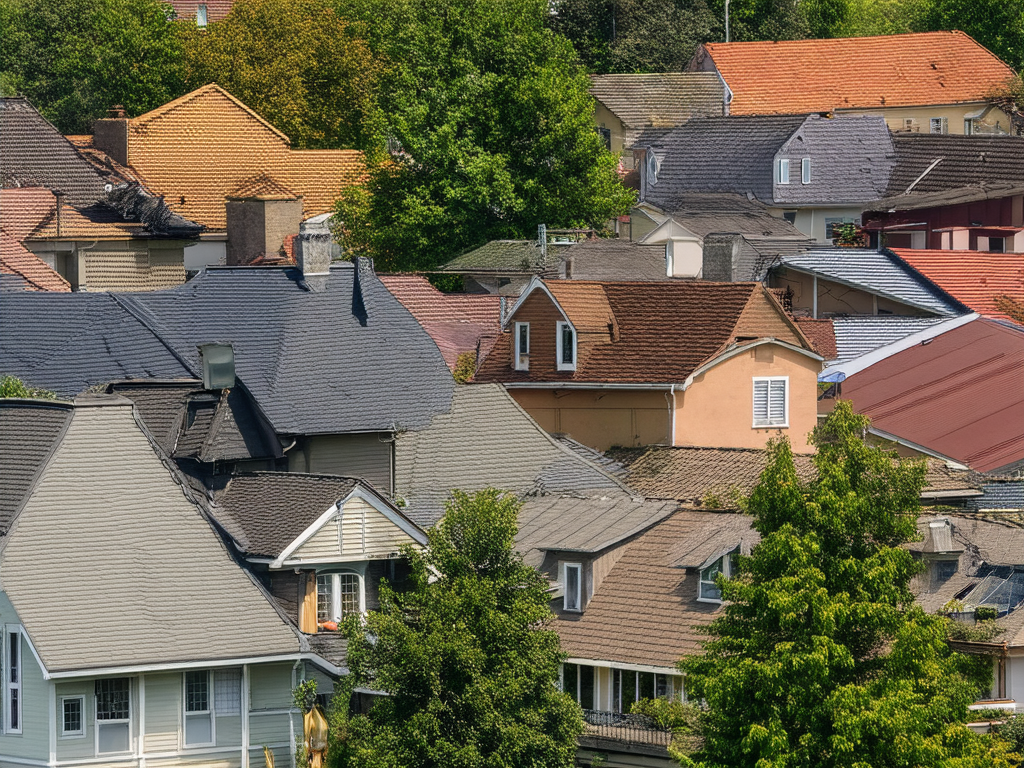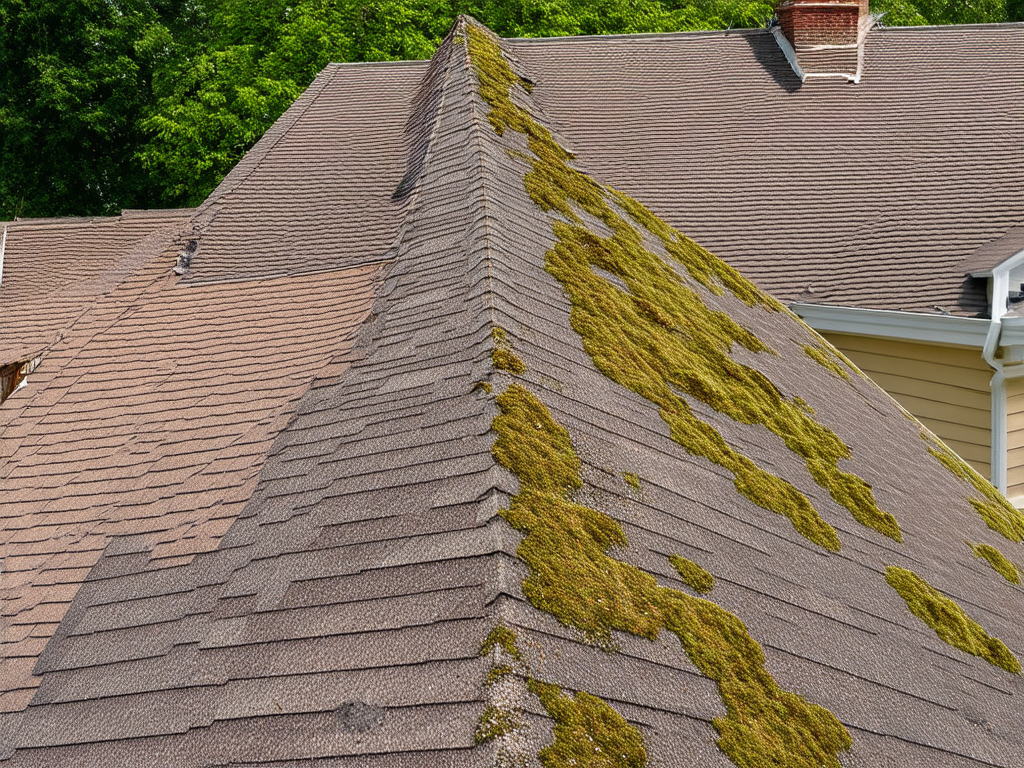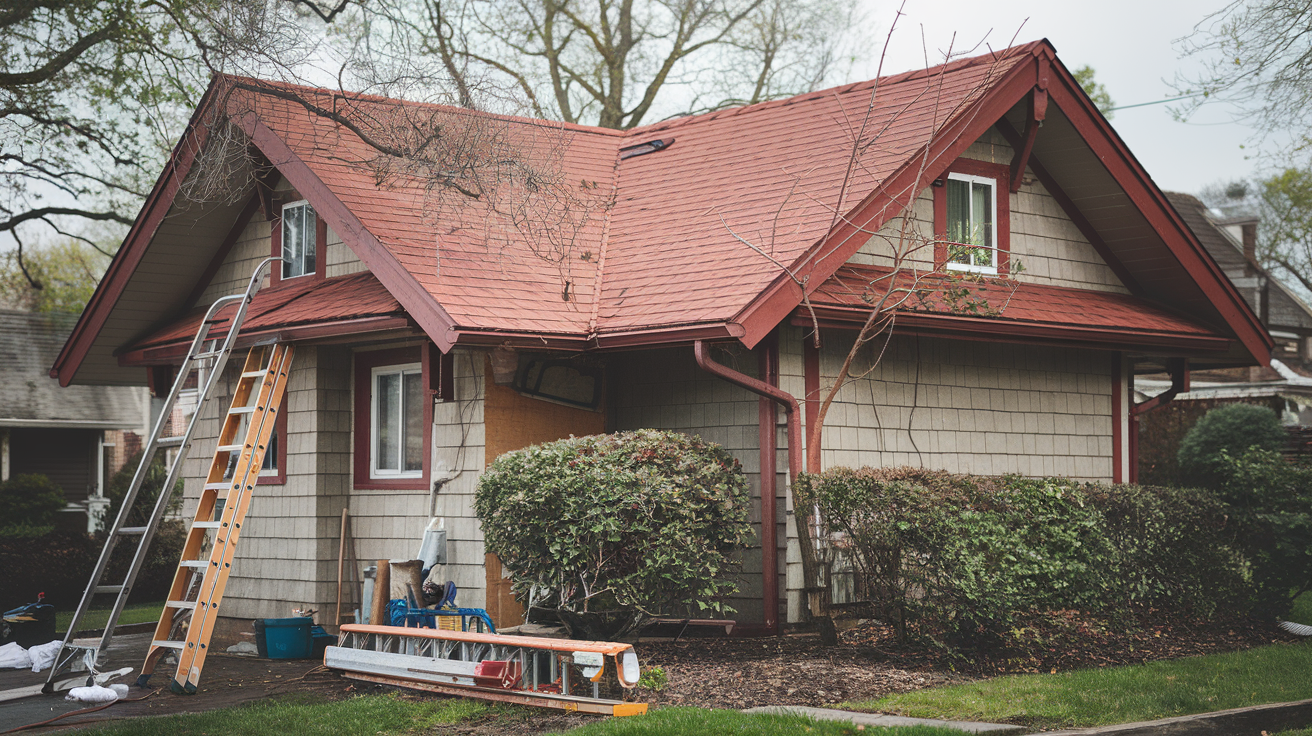Ultimate Roof Maintenance Guide: Extend Your Roof's Life by Years
Your roof silently protects your home 24/7, yet most homeowners only think about it when there's a problem. With roof repairs averaging $9,000 and full replacements costing upwards of $24,000, neglecting maintenance can be a costly mistake. According to industry data, 70-90% of insured property damage comes from roof-related issues, making proper care essential for protecting your biggest investment.
This comprehensive guide will walk you through everything you need to know about roof maintenance, from understanding different materials' lifespans to creating a preventative care schedule that works for your climate. You'll learn how to spot early warning signs of damage, perform basic maintenance tasks safely, and know when to call professionals.
Whether you have asphalt shingles that need regular inspection or a metal roof requiring specific care, we'll help you extend your roof's life and avoid expensive repairs. By following our expert-backed maintenance tips, you can add years to your roof's lifespan while protecting your home and wallet.
Table of Contents
- Understanding Roof Lifespan and Material Choices
- Key Warning Signs and Common Roof Problems
- Essential Roof Maintenance Tasks
- Cost Implications and Financial Considerations
- Regional Considerations and Building Codes
Understanding Roof Lifespan and Material Choices
A roof isn't just about curb appeal; it's your home's first line of defense against the elements. Understanding a roof's lifespan and the various material choices available is crucial for effective maintenance. A well-maintained roof protects your home and can significantly impact its value. Making informed decisions about roofing materials affects both its longevity and required maintenance. Choosing high-quality materials suitable for your climate can extend your roof's life and reduce frequent repairs. You can also learn more about roof maintenance to make informed decisions.

Lifespan of Common Roofing Materials
Different roofing materials have varying lifespans, impacting long-term maintenance plans. Understanding these lifespans is key to budgeting and planning for future replacements.
Asphalt Shingles
Asphalt shingles are a popular choice due to their affordability. Industry data shows they typically last 15-30 years.
- 3-Tab Shingles: These have a shorter lifespan of 10-20 years, especially in temperate climates.
- Architectural Shingles: These offer increased longevity, lasting 30-50 years. While cost-effective, they may require more frequent maintenance.
Metal Roofs
Known for durability, metal roofs last 40-70 years or more. While the initial cost is higher, minimal maintenance can lead to long-term savings. Proper maintenance ensures a metal roof can last 50+ years.
Concrete and Clay Tiles
Concrete and clay tiles offer exceptional longevity, exceeding 50 years. This makes them a great option for homeowners seeking a roof that lasts.
Impact of Climate on Roof Longevity
Climate significantly impacts a roof's lifespan. Extreme weather, like heavy snow or intense heat, accelerates deterioration.
Effects of Extreme Weather
Intense sun can degrade asphalt shingles quickly, while temperature swings can cause thermal shock, leading to cracks and damage in some materials. Choosing a material that withstands your region's climate is essential. Consider factors like precipitation and sun exposure when selecting your roofing material.
Metal Roof Performance
Metal roofs excel in various climates, effectively withstanding heat and UV rays. This makes them well-suited for areas with temperature fluctuations, like California. Get Your Roof Assessment to determine the best roofing material for your specific climate.
Choosing the Right Roofing Material for Your Region
Selecting the right material involves balancing local climate considerations with your long-term maintenance goals.
Moderate Climates
In moderate climates, asphalt shingles offer a practical, cost-effective solution due to easy installation and repair. For a 1,500 square foot roof, asphalt shingles cost between $7,500 and $24,000.
Severe Weather Regions
For areas with severe weather, metal roofing provides enhanced protection. Roof damage accounts for 70-90% of insured property damage from catastrophic weather, emphasizing the need for resilient materials. While metal roofs offer excellent durability, consider factors like cost and aesthetics. Metal roofs generally start at $12 per square foot.
Professional Consultation
Consulting a professional roofing company provides personalized guidance. They can help you choose a material that suits your home's design and addresses your area's weather challenges. Professionals can also explain maintenance needs, including cleaning frequency. For instance, metal roofs require less cleaning than asphalt shingles or wood shakes.
Key Warning Signs and Common Roof Problems
Identifying potential issues early is crucial for saving time and money on roof repairs. Understanding the signs of damage, both inside and outside your home, can prevent minor issues from becoming major expenses. Regularly assessing your roof's condition and scheduling preventative maintenance can help extend its lifespan and protect your investment. Consider scheduling a Get Your Roof Assessment for a comprehensive evaluation.
Internal Signs of Roof Damage
Internal signs often provide the first clues of roof problems. Water stains on your ceilings or walls are a common indicator of leaks. Similarly, holes, openings, or rotting in your ceiling also point to potential roof damage. Even without visible leaks, problems can hide in the attic. Check your attic insulation for dampness or water marks, even if your ceilings appear dry. Other internal red flags include sagging ceilings and the presence of mold or mildew, which can signal underlying roof issues.
External Indicators of Wear and Tear
The exterior of your roof offers valuable insights into its condition. Missing or broken shingles are obvious signs of damage and potential need for repair or replacement. Other external indicators include granules in your gutters, which suggest shingle deterioration. Excessive moss growth and warping of roofing materials also warrant attention. After a storm, check for branches on your roof or any visible damage, which could indicate wind damage. While a visual check from the ground is helpful, avoid climbing on your roof, especially after severe weather. Instead, contact a professional for a thorough inspection.
Common Roofing Problems by Material Type
Different roofing materials have unique vulnerabilities. Asphalt shingles are susceptible to cracking, blistering, and dislodging over time. Wood shakes can warp or rot without proper care. Metal roofs, known for low maintenance, can corrode if their protective coatings fail. Understanding the weaknesses of your specific roofing material allows for targeted maintenance. Factors such as climate and weather, including temperature fluctuations, precipitation, and sun exposure, also impact a roof's lifespan. For instance, impact-resistant shingles are recommended for areas with frequent hailstorms.

Essential Roof Maintenance Tasks
Maintaining your roof is crucial for extending its lifespan and protecting your home. Regular maintenance prevents costly repairs, which can average around $9,000 for a full replacement. This section explores essential maintenance tasks for various roofing materials, offering actionable tips to safeguard your investment. Consider scheduling a Get Your Roof Assessment to identify potential issues early.
Recommended Maintenance for Asphalt Shingles
Asphalt shingles are a popular roofing choice due to their affordability and easy installation. However, regular maintenance is essential to maximize their 15- to 30-year lifespan.
Inspecting for Damage
After storms, look for cracked, curled, or missing shingles. Dark spots on your ceiling or missing shingles can indicate roof damage. Promptly replacing damaged shingles prevents leaks. While individual shingle replacement is often sufficient, widespread damage from severe weather might require a full replacement.
Cleaning Gutters
Clean gutters and downspouts regularly to prevent water backup and roof damage. Use a ladder, gloves, and a small scoop to remove debris, then flush with water. Bi-annual cleaning is recommended.
Moss and Algae Removal
Moss and algae can degrade shingles. Remove them using a specialized roof cleaner or a water-bleach mixture. This prevents moisture buildup and premature deterioration.
Best Practices for Metal Roofs
Metal roofs are renowned for durability, lasting 40–70 years or more with proper care. While they require less maintenance than other materials, some tasks are still crucial.
Regular Inspections
Regularly check for loose or damaged panels, secure fasteners, and signs of rust. Apply a metal roof coating to prevent corrosion. Bi-annual professional inspections are recommended, along with visual checks after major storms.
Cleaning
Clean your metal roof with mild detergent and water, avoiding abrasive materials. Proper installation on a sloped roof contributes to a lifespan of 30 years or more.
Tree Trimming
Trim overhanging branches to prevent damage during high winds. While metal roofs are more resistant than asphalt shingles, falling branches can still cause problems.
Tile Roof Maintenance Tips
Tile roofs (clay or concrete) offer a lifespan of 50+ years. However, specific issues require attention.
Crack and Chip Inspection
Regularly inspect tiles for cracks or chips, replacing damaged pieces promptly to prevent leaks. Annual visual inspections, especially after harsh weather, are recommended. Consider professional inspections every few years.
Moss and Lichen Control
Use copper- or zinc-based solutions to control moss and lichen growth, which can degrade tiles. These solutions create an environment that inhibits their growth.
Gutter Maintenance
Clean gutters regularly to prevent water from pooling and causing damage. Standing water can lead to leaks, structural issues, and mold growth.
Wood Shake Roof Care
Wood shake roofs, known for their rustic aesthetic, require more maintenance than other types. Their lifespan varies from 20–40 years depending on climate and upkeep.
Regular Sealing
Apply a wood preservative or sealant every few years to protect against moisture and UV damage. Consult a professional for guidance on sealing frequency based on climate and wood type.
Debris Removal
Regularly remove leaves and branches to prevent moisture retention and rot. Accumulated debris can lead to mold, mildew, and a shorter lifespan.
Mold and Mildew Prevention
Treat the roof with anti-fungal solutions annually or as needed, especially in humid climates or after heavy rain, to maintain wood integrity.
By following these maintenance practices, you can extend your roof's lifespan and protect your home. Regular inspections and timely repairs prevent small issues from escalating. A roof's lifespan depends on material quality, climate, and maintenance. While regular maintenance is crucial, it doesn't guarantee a specific lifespan. However, neglecting maintenance can significantly shorten its life and lead to substantial costs. Proactive maintenance can result in significant long-term savings. Learn more about roof maintenance and schedule a Get Your Roof Assessment for personalized recommendations.
Cost Implications and Financial Considerations
Understanding the financial aspects of roofing is crucial for homeowners. A new roof is a significant investment, and costs vary based on materials, roof size, and installation complexity. This section explores average installation costs, compares long-term expenses, and offers budgeting tips for maintenance and repairs. Planning your budget effectively ensures you get the best value for your investment. Consider getting a roof assessment to understand your specific needs.
Average Installation Costs by Material
Roof installation costs depend heavily on the chosen materials. Asphalt shingles are generally the most affordable, ranging from $4 to $11 per square foot. This translates to $4,000–$11,000 for a 1,000-square-foot roof. A typical 2,000-square-foot roof costs around $15,000 for complete installation, including materials, labor, and old roof removal. Metal roofs offer greater durability and longevity, starting at approximately $12 per square foot. A 2,000-square-foot metal roof could start at $24,000. While the initial cost is higher, metal roofs last 40 to 70 years or more, compared to 15–30 years for asphalt shingles. Learn more about roof maintenance and different roofing materials.
Long-term Cost Comparisons and Savings
Evaluating long-term costs and potential savings is essential. Asphalt shingles, while initially cheaper, require more frequent replacement due to their shorter lifespan of 15–30 years. A homeowner might replace an asphalt shingle roof two or three times over the lifespan of a single metal roof. Metal roofs (lasting 50–70 years) may offer better long-term value. A durable roof can also reduce energy bills and insurance premiums, along with maintenance costs. Proactive roof maintenance can lead to significant savings, potentially averaging $11,274 annually. This might be attributed to fewer repairs and replacements. Such maintenance includes regular cleaning, inspections, and prompt repairs.
Budgeting for Maintenance and Repairs
Budgeting for roof maintenance and repairs is vital for maximizing roof lifespan and preventing costly damage. Set aside funds for regular inspections and maintenance to address minor issues before they escalate. For instance, repairing a small leak early prevents extensive water damage and costly repairs later. Neglecting a small leak could lead to rot, mold, and damage to insulation or ceilings, significantly increasing repair expenses. Experts advise bi-annual roof inspections, ideally in spring and fall. Spring inspections assess damage from winter weather, while fall inspections prepare the roof for the next winter. Budget for unexpected repairs, as roof-related damage often accounts for 70% to 90% of insured property damage from severe weather. Planning and budgeting for these costs ensures your roof stays in good condition and avoids financial strain.
Regional Considerations and Building Codes
Regional factors and building codes play a vital role in roof maintenance. Your local climate significantly affects how long your roof lasts and how well it performs. Extreme temperature changes can cause roofing materials to expand and contract, leading to cracks and leaks. Local building codes ensure roofs can handle these conditions. By following these codes and adjusting your maintenance routine to your region, you can protect your roof and make it last longer. This could mean choosing materials designed for your climate, like metal for hot areas or impact-resistant shingles for hail-prone regions, or making sure you have good ventilation to prevent moisture buildup that can lead to rot and mold. A typical roof lasts 25 to 50 years, depending on the material and upkeep, so proper care is key. Consider getting a roof assessment to determine the current condition of your roof.
Climate-Specific Maintenance Schedules
Different climates require different maintenance schedules. In hot, dry areas, roofs often wear down quickly from the sun and heat. The sun can make materials brittle and cracked. Regular checks for cracks and damage are important in these regions. It's like using sunscreen; roof maintenance protects it from the sun. Areas with lots of rain need frequent checks for leaks, especially around chimneys and skylights. These spots can be weak if the sealant isn't good. Seasonal maintenance should include cleaning gutters and downspouts to prevent water buildup. This is vital in rainy areas, as clogged gutters can overflow and damage the roof and surrounding areas. Learn more about roof maintenance to develop a personalized plan.
Maintenance for Cold Climates
Cold climates bring problems like ice dams and freeze-thaw cycles. Ice dams form when melting snow refreezes, stopping water from draining and causing leaks. This water can seep under shingles and into your home. Good attic insulation helps prevent ice dams. Proper attic ventilation also helps control temperature and reduce snowmelt. Check for leaks during the spring thaw to avoid mold and structural problems. Watch for water stains on ceilings or walls.
Maintenance for Coastal Regions
Coastal roofs face salt spray and high winds. Regularly washing with fresh water, especially on metal roofs, helps remove salt buildup. Salt spray can corrode metal and shorten its life. Secure loose shingles and ensure flashing is intact to protect against wind and rain. Flashing, which seals around chimneys and vents, is vulnerable to wind damage in coastal regions. High winds can damage flashing and let water in.

Understanding Local Building Codes
Local building codes ensure roofs are safe and meet regional standards. These codes cover materials, load capacity, and installation. In hurricane zones, codes might require roofs to be anchored against high winds. This could involve stronger fasteners or hurricane clips. Homeowners should check with local authorities or contractors about specific rules in their area. Information is often available on city or county websites. Building codes change, so stay updated.
Compliance and Inspections
Following building codes is not only safe but can also affect insurance. Some insurers won't cover damage from non-compliant roofs. Regular checks by pros can find problems and needed upgrades. This can prevent costly repairs and legal issues. Inspections can also catch small problems early, making them cheaper to fix. A small leak caught early might be a simple fix, while a big one could mean a new roof.
Weather poses big risks to roofs, so being prepared is essential. In the U.S., roof damage makes up 70% to 90% of insured property damage from severe weather. Being ready means knowing local risks and taking preventive steps. Understanding your region's weather helps you prepare.
Storm Preparation
Before storms, check your roof for loose or damaged shingles and secure weak areas. Strengthening the roof and using storm-resistant materials can lessen wind and hail damage. Impact-resistant shingles handle hail better than regular ones. A backup power source for sump pumps can prevent water damage during outages. A generator can keep your sump pump working even if the power goes out.
Heat and Sun Exposure
In sunny areas, cool roofs or reflective coatings can reduce heat and make your roof last longer. Cool roofs reflect sunlight and absorb less heat, saving energy. This also reduces wear and tear on the roof, preventing early aging. This is especially good for asphalt shingles, which can become brittle in the heat.
By understanding regional needs and following building codes, homeowners can make their roofs stronger and last longer. Matching maintenance and preparation to local conditions ensures your roof protects your home for years.
Disclaimer: This blog post is intended for informational purposes only and should not be considered professional roofing advice. Always consult with qualified roofing contractors and insurance professionals for specific guidance regarding your individual circumstances.
